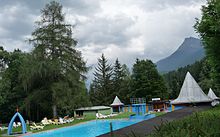Beda Hefti
Beda Hefti (born March 23, 1897 in Walenstadt ; † January 21, 1981 in Freiburg ) was a Swiss civil engineer and architect .
Life
Beda Hefti was born in Walenstadt as the son of Thomas Hefti and Berta, née Linder. Hefti studied at the Federal Institute of Technology Zurich and graduated in 1918 with a diploma as a civil engineer from. Beda Hefti, who as an engineer belonged to the Swiss Association of Engineers and Architecture (SIA) , settled in Freiburg in 1920 and opened an engineering office there.
Hefti, technically up-to-date and a pioneer of the hygiene movement, was a pioneer of sports buildings, especially a large number of swimming pools with state-of-the-art technology, some of which he designed himself, some of which he planned the technology as an engineer, including the Bains de la Motta in Freiburg 1924, as well as the swimming pools Gstaad 1927, Murten 1929, Burgdorf 1929, Hotel Waldhaus Vulpera 1930, Monthey 1930, Engelberg 1930, Im Gruebi in Adelboden 1931, Goldey in Interlaken 1931, Wengen 1931, Eglisee Basel 1931, swimming and sunbathing Heiden 1932, Grenchen 1956, and Renens and Payerne in 1969. In addition, from 1940 onwards he increasingly dealt with water supply , bridge and road construction as well as industrial construction and constructed the silo structures in Düdingen , Matran , Chavornay and Yvonand . Furthermore, as a partner of Denis Honegger and Fernand Dumas, he was involved in the construction of the Miséricorde university building in Freiburg. Beda Hefti's contribution to this building project were calculations for the “bâtiment des cours”, with the large auditorium B and three other smaller auditoriums, some of which protrude from the facade. Around 1930 Hefti changed his construction method from the neoclassical style to the new building .

As the inventor and holder of several patents, in 1938 he developed a new type of ski lift that was installed in Montana , Andermatt and Châtel-St-Denis . In addition, he was the founder of numerous sports clubs in the canton of Friborg , such as the later basketball club Friborg-Olympic in 1941 and the initiator of the Murtenlauf in 1933 . The Freiburg football stadium, the Stade Universitaire St-Léonard, was also built in 1932 under his leadership. Another field of activity of Beda Hefti was the Aérodrome d'Écuvillens southwest of Freiburg, and the parachutists who start from there.
Private life
Beda Hefti came from an Evangelical Reformed family. In 1925 he married the German swimmer Hildegard Daniel from Trossingen . With her he had a son who was born in 1923 and who later emigrated to South Africa as a young engineer. This first marriage was divorced in 1957 in Geneva . His daughter was born in 1952. In the same year, his mother, the young Friborg Marie-Thérèse Morel, Beda Hefti's life partner, died in a traffic accident. From 1967 he increasingly withdrew from his professional activity. After that he lived mainly in Villars-sur-Glâne .
literature
- Isabelle Rucki, Dorothee Huber (Hrsg.): Architects Lexicon of Switzerland 19./20. Century. Birkhäuser, Basel 1998, ISBN 3-7643-5261-2 , p. 259.
- Jean-Luc Rime et al .: Beda Hefti, Ingénieur, 1897-1981. Pro Friborg (Ed.), Volume 3, No. 184. Friborg 2014
Web links
- Christoph Allenspach: Hefti, Beda. In: Historical Lexicon of Switzerland .
- Biography of Beda Hefti on the website of the Museum Society Grenchen
- Outdoor swimming pools in Switzerland. Who needs the sea anyway?
Individual evidence
- ^ Freiburger Nachrichten of September 24, 2014: A tribute to Beda Hefti
- ↑ Christa Zeller: Restored seduction of the thirties . In: Werk, Bauen und Wohnen Issue 10/2000. P. 2
- ↑ The new Beda Hefti ski lift system . In: Schweizerische Bauzeitung, issue 13/1938. Pp. 156-159
- ↑ a b Jean-Luc Rime, et al .: Beda Hefti, Ingénieur, 1897-1981 . Ed .: Pro Friborg. tape 3 , no. 184 . Friborg 2014, p. 16-19, 21, 30, 34, 85 ff., 89-93 .
| personal data | |
|---|---|
| SURNAME | Hefti, Bede |
| BRIEF DESCRIPTION | Swiss architect |
| DATE OF BIRTH | March 23, 1897 |
| PLACE OF BIRTH | Walenstadt |
| DATE OF DEATH | January 21, 1981 |
| Place of death | Friborg , Switzerland |
